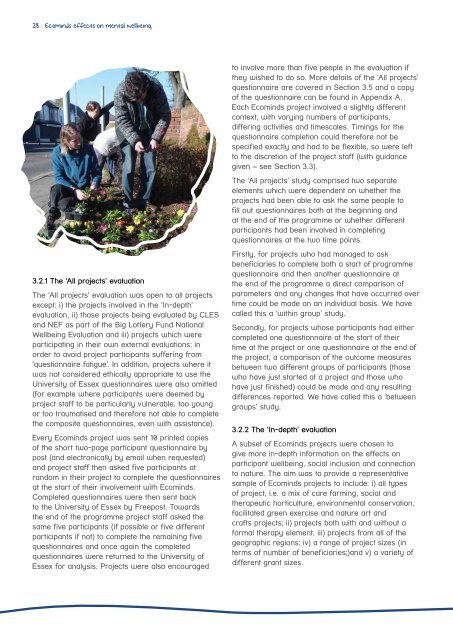Ecominds-effects-on-mental-wellbeing-evaluation-report
Ecominds-effects-on-mental-wellbeing-evaluation-report
Ecominds-effects-on-mental-wellbeing-evaluation-report
You also want an ePaper? Increase the reach of your titles
YUMPU automatically turns print PDFs into web optimized ePapers that Google loves.
28 <str<strong>on</strong>g>Ecominds</str<strong>on</strong>g> <str<strong>on</strong>g>effects</str<strong>on</strong>g> <strong>on</strong> <strong>mental</strong> <strong>wellbeing</strong>to involve more than five people in the evaluati<strong>on</strong> ifthey wished to do so. More details of the ‘All projects’questi<strong>on</strong>naire are covered in Secti<strong>on</strong> 3.5 and a copyof the questi<strong>on</strong>naire can be found in Appendix A.Each <str<strong>on</strong>g>Ecominds</str<strong>on</strong>g> project involved a slightly differentc<strong>on</strong>text, with varying numbers of participants,differing activities and timescales. Timings for thequesti<strong>on</strong>naire completi<strong>on</strong> could therefore not bespecified exactly and had to be flexible, so were leftto the discreti<strong>on</strong> of the project staff (with guidancegiven – see Secti<strong>on</strong> 3.3).The ‘All projects’ study comprised two separateelements which were dependent <strong>on</strong> whether theprojects had been able to ask the same people tofill out questi<strong>on</strong>naires both at the beginning andat the end of the programme or whether differentparticipants had been involved in completingquesti<strong>on</strong>naires at the two time points.3.2.1 The ‘All projects’ evaluati<strong>on</strong>The ‘All projects’ evaluati<strong>on</strong> was open to all projectsexcept: i) the projects involved in the ‘In-depth’evaluati<strong>on</strong>, ii) those projects being evaluated by CLESand NEF as part of the Big Lottery Fund Nati<strong>on</strong>alWellbeing Evaluati<strong>on</strong> and iii) projects which wereparticipating in their own external evaluati<strong>on</strong>s; inorder to avoid project participants suffering from‘questi<strong>on</strong>naire fatigue’. In additi<strong>on</strong>, projects where itwas not c<strong>on</strong>sidered ethically appropriate to use theUniversity of Essex questi<strong>on</strong>naires were also omitted(for example where participants were deemed byproject staff to be particularly vulnerable, too youngor too traumatised and therefore not able to completethe composite questi<strong>on</strong>naires, even with assistance).Every <str<strong>on</strong>g>Ecominds</str<strong>on</strong>g> project was sent 10 printed copiesof the short two-page participant questi<strong>on</strong>naire bypost (and electr<strong>on</strong>ically by email when requested)and project staff then asked five participants atrandom in their project to complete the questi<strong>on</strong>nairesat the start of their involvement with <str<strong>on</strong>g>Ecominds</str<strong>on</strong>g>.Completed questi<strong>on</strong>naires were then sent backto the University of Essex by Freepost. Towardsthe end of the programme project staff asked thesame five participants (if possible or five differentparticipants if not) to complete the remaining fivequesti<strong>on</strong>naires and <strong>on</strong>ce again the completedquesti<strong>on</strong>naires were returned to the University ofEssex for analysis. Projects were also encouragedFirstly, for projects who had managed to askbeneficiaries to complete both a start of programmequesti<strong>on</strong>naire and then another questi<strong>on</strong>naire atthe end of the programme a direct comparis<strong>on</strong> ofparameters and any changes that have occurred overtime could be made <strong>on</strong> an individual basis. We havecalled this a ‘within group’ study.Sec<strong>on</strong>dly, for projects whose participants had eithercompleted <strong>on</strong>e questi<strong>on</strong>naire at the start of theirtime at the project or <strong>on</strong>e questi<strong>on</strong>naire at the end ofthe project, a comparis<strong>on</strong> of the outcome measuresbetween two different groups of participants (thosewho have just started at a project and those whohave just finished) could be made and any resultingdifferences <strong>report</strong>ed. We have called this a ‘betweengroups’ study.3.2.2 The ‘In-depth’ evaluati<strong>on</strong>A subset of <str<strong>on</strong>g>Ecominds</str<strong>on</strong>g> projects were chosen togive more in-depth informati<strong>on</strong> <strong>on</strong> the <str<strong>on</strong>g>effects</str<strong>on</strong>g> <strong>on</strong>participant <strong>wellbeing</strong>, social inclusi<strong>on</strong> and c<strong>on</strong>necti<strong>on</strong>to nature. The aim was to provide a representativesample of <str<strong>on</strong>g>Ecominds</str<strong>on</strong>g> projects to include: i) all typesof project, i.e. a mix of care farming, social andtherapeutic horticulture, envir<strong>on</strong><strong>mental</strong> c<strong>on</strong>servati<strong>on</strong>,facilitated green exercise and nature art andcrafts projects; ii) projects both with and without aformal therapy element, iii) projects from all of thegeographic regi<strong>on</strong>s; iv) a range of project sizes (interms of number of beneficiaries;)and v) a variety ofdifferent grant sizes.



